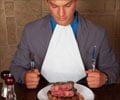Learn how neurons can help in controlling obesity and metabolic diseases by balancing hunger and pleasure-driven eating.

‘Activating specific #neurons boosts #hunger #eating and controls pleasure eating, aiding in obesity prevention.#medindia’





According to co-corresponding author Dr. Yong Xu, a pediatrician and associate director for basic sciences at the USDA/ARS Children's Nutrition Research Center at Baylor College of Medicine, "ideal feeding habits would balance eating for necessity and for pleasure, minimizing the latter." "In this study, we discovered a subset of neurons that controls the brain's mechanism for balanced feeding".(1✔ ✔Trusted SourceDistinct basal forebrain-originated neural circuits promote homoeostatic feeding and suppress hedonic feeding in male mice.
Go to source)
Balancing Hunger and Pleasure
Previous studies have highlighted the role of neurons identified by the GABAergic proenkephalin (Penk) marker, an endogenous opioid hormone, on feeding andIn this study, Xu and his colleagues showed that activation of Penk neurons in the brain region called diagonal band of Broca (DBB) of male mice supports an ideal feeding pattern, increasing hunger-driven feeding while reducing pleasure-driven eating.
“I was surprised by this finding,” Xu said. “We and other groups had previously shown that certain groups of neurons affect both feeding types in the same way – they either increase or decrease both types. Here we found that activating DBB-Penk neurons has opposite effects in the two types of feeding, they increase hunger-driven feeding while decreasing eating for pleasure”.
The researchers investigated the mechanism mediating these opposite effects. They discovered that DBB-Penk neurons project into two different brain areas, one regulates hunger-driven feeding and the other controls pleasure-driven eating.
Advertisement
Neurons Activated During Cravings
“A subset of DBB-Penk neurons that projects to the paraventricular nucleus of the hypothalamus is preferentially activated upon food presentation during fasting periods, facilitating hunger-driven feeding,” Xu said. “On the other hand, a separate subset of DBB-Penk neurons that projects to a different brain region, the lateral hypothalamus, is preferentially activated when detecting high-fat, high-sugar (HFHS) foods and inhibits their consumption. This is the first study to show a neural circuit that is activated by a reward, HFHS, but leads to terminating instead of continuing the pleasurable activity.”Strikingly, mice in which the entire DBB-Penk population had been eliminated when given free choice of chow and HFHS diets, reduced consumption of chow but increased intake of the HFHS diet, resulting in accelerated development of obesity and metabolic disturbances.
Advertisement
Reference:
- Distinct basal forebrain-originated neural circuits promote homoeostatic feeding and suppress hedonic feeding in male mice.- (https:www.nature.com/articles/s42255-024-01099-4)
Source-IANS












